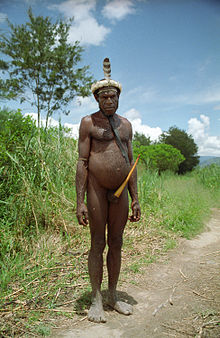Dani
The Dani are an indigenous people in New Guinea (Irian Jaya Province). Some sources put the size of the Dani population at 250,000, others at only 40,000. The Dani men often wear the penis sheath called Koteka . Other tribes in the Baliem Valley are the Lani (in the west) and the Yali in the south-east.
Way of life

The way of life of the Dani is different from the way of life of other highland tribes. On the one hand, this is due to a special type of settlement (settlements are fortified with palisade fences , carefully laid out gardens, round family and men's houses, as well as long kitchens and elongated stables for cattle). On the other hand, the social order of the Dani is based on the clan system, which is associated with a high degree of responsibility.
The huts are covered with sturdy grass roofs, which offers the residents sufficient protection against the occasional torrential rain. The family hut is a refuge for the whole family. The men's huts, on the other hand, are taboo for women. Since polygamy corresponds to recognized moral behavior, it is incumbent on the man to build his own family hut for each of his women. Women predominate in the Dani clans, which is why polygamy has a pragmatic purpose and emphasizes responsibility for the clan.
Another task of the Dani man is the creation of a field for (each) his (r) wife (s). The order of the extension is subject to strict division of responsibilities. The Dani live on a subsistence basis from their cultivation in the fields. They feed on various tuber fruits, such as sweet potatoes , cassava or yams , as well as beans, bananas and pandanus fruits . Sugar cane is also used. In addition, pigs are kept as pets and only rarely slaughtered at special festivals ( pig festival ). The pig festival represents the absolute highlight of the social-religious life of many highland tribes and is repeated at most every 2–10 years. On the occasion of these festivals, weddings, ancestral cults and mourning and initiation rites are celebrated. In addition to the domestic pigs, the Dani maintain a type of wild boar.
Once very belligerent, the Dani now present themselves as pleasant and sensitive. Only the names of the battlefields recall this past, like Dugum Dani at Akima .
language
The Dani language is the subject of numerous ethno-linguistic studies. There are e.g. B. only two terms to describe colors: a collective term for all light / warm and one for cold / dark shades. Eleanor Rosch used this peculiarity to test the Sapir-Whorf hypothesis .
Others
Heinrich Harrer's more than 100 porters on the first ascent of the 4884 m high Puncak Jaya were Dani. In 1962, Harrer also researched how the Dani made stone axes from epidote and glaucophane ( amphibole ). When crossing the Baliem Valley to the south coast, tribal wars often endangered him and his Dani and Lani porters. The Heinrich Harrer Museum in Hüttenberg shows exhibits from Harrer's research trip to New Guinea.
literature
- Heinrich Harrer: From the Danis. In the S. (Ed.): Among Papuans. People and culture since their stone age. Pinguin, Innsbruck 1976 ISBN 3-596-23508-1 .
- Heinrich Harrer: I come from the Stone Age. Eternal ice in the jungle of the South Seas , Ullstein, Frankfurt / M. 1963 (Fischer-Verlag 1984) ISBN 978-3-596-23506-3 .
- Steffen Keulig: Nightmare Civilization - Back to the Stone Age. A journey to the forest people of New Guinea. Meridian, Rostock 2002. ISBN 3-934121-04-7
- Helen Manning: To perish for their saving ; Udo Rühl (German translation): The martyrs from the Sengtal: Pioneer mission today among the indigenous people of West Irian , VLM, Bad Liebenzell 1974, ISBN 978-3-88002-000-9 .
Web links
- Anton Ploeg: Some comparative remarks about the Dani of the Baliem valley and the Dani at Bokondini. In: Bijdragen tot de Taal-, Land- en Volkenkunde 122, no. 2, Leiden 1966, pp. 255–273
- Anton Ploeg: Legacies of an unknown past. In: Bijdragen tot de Taal-, Land- en Volkenkunde 144, no. 4, Leiden 1988, pp. 510-522
- Chris Ballard: Dani Bibliography. In: Center for Pacific and Asian Studies, Hong Kong: Oceania Newsletter 11/12, February – August 1993
Individual evidence
- ↑ Simon Akstinat: Akstinat's Fascinating Facts . Humboldt, Baden-Baden 2006, ISBN 3-89994-066-0 , p. 46 ( limited preview in Google Book search).
